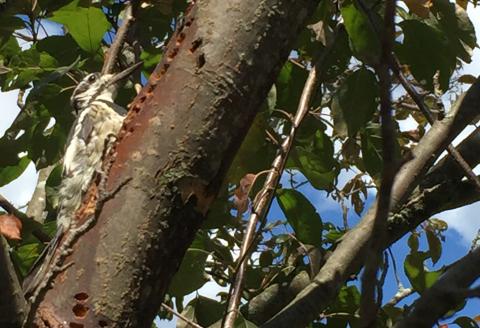Gridwork

I discovered an issue on a crabapple tree in my front yard recently. The culprit for the damage to my tree: the yellow-bellied sapsucker, Sphyrapicus varius, a species of woodpecker native to the eastern United States.
The feeding behavior of this bird is to drill holes in the tree bark in neatly spaced rows, returning periodically to feed on the sap that oozes out and also exposing cambium and other tree tissue and sap for insects, which they also eat. (The Audubon field guide says the adult sapsuckers teach their young the sapsucking habit for 10 days after they leave the nest.)
 Sapsucker damage is easy to identify; the holes are approximately 0.25 inch in diameter drilled in horizontal and vertical rows creating a grid-like pattern. Often, this is mistaken for insect damage such as borers or beetles, however insects produce fewer, smaller holes, which are more randomly distributed, with visible frass (insect feces) on the ground under the tree. Unlike other woodpeckers, sapsuckers drill specifically for sap, not insects, and benefit when opportunistic insects that are attracted to the sap move in. (On this day, green-headed flies were amassed on one of the grids in my tree.)
Sapsucker damage is easy to identify; the holes are approximately 0.25 inch in diameter drilled in horizontal and vertical rows creating a grid-like pattern. Often, this is mistaken for insect damage such as borers or beetles, however insects produce fewer, smaller holes, which are more randomly distributed, with visible frass (insect feces) on the ground under the tree. Unlike other woodpeckers, sapsuckers drill specifically for sap, not insects, and benefit when opportunistic insects that are attracted to the sap move in. (On this day, green-headed flies were amassed on one of the grids in my tree.)
These birds will feed on both hardwoods and conifers, but prefer a tree with thin bark. If caught early, they say burlap can be wrapped around the trunk to discourage the birds from their mission, or by tying shiny objects in the trees. However, according to WSU Extension Forestry Educator Kevin Zobrist, the birds are persistent, and once moved in will likely target a neighboring tree if discouraged. If sapsuckers appear to favor a specific tree, it might be best to leave this “sacrifice” tree until the group moves on.*
Sapsuckers, like all woodpeckers, are protected by the Federal Migratory Bird Treaty Act.
The little tree in my yard has been a focal point for many years. In the fall, it is the tree that is full of cedar waxwings. I love the color of the bark, the overall shape of the tree, the size and shape of its tiny apples, and its prolific fruiting habits. Needless to say, I’m taking this lesson from Mother Nature sulking. I don’t think the odds for its survival are very bright.
______________________________________________
For more information view *Recognizing Sapsucker Damage on your Trees or contact our UNH Cooperative Extension Education Center (1-877-398-4769 or answer@unh.edu).
